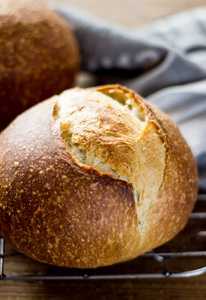- 5.35 oz / 150g active, fed starter
- 8.8 oz / 250g water, preferably filtered
- 0.9 oz / 25g olive oil
- 17.65 oz / 500g bread flour (not all purpose)
- 0.35 oz / 10g fine sea salt fine ground cornmeal, for dusting
- To make the dough: In a large bowl, combine the starter, water, olive oil and bread flour. Squish everything together with your hands until all of the flour is absorbed. Rest (autolyse) for 30 minutes.
- Add the salt + 1/2 tsp. of water (to help it dissolve). Lift and fold the dough over itself several times, and squish with your hands to incorporate. The dough will tear slightly as you fold, and the salt will not fully dissolve. Don't worry this is normal. Work the dough as best you can until it comes back together into a rough ball. At this point, you shouldn't feel any grains of salt beneath your hands.
- Bulk fermentation: Cover your bowl with plastic wrap and a clean kitchen towel. Leave it in a warm, sunny spot to rise. Your dough is ready when it no longer looks dense, and has increased in volume about 11/2 2x its original size. This can take anywhere from 312 hours depending on the temperature of your ingredients, the potency of your starter and surrounding environment. I make my dough in the afternoon, and leave it to rise overnight. See my Winter Weekend Baking schedule (in post above) for more details.
- Stretch & folds: During bulk fermentation, you have the option to perform a series of 'stretch & folds' to strengthen the dough. Simply gather a portion of the dough, stretch it upwards and then fold it over itself. Rotate the bowl 1/4 turn and repeat this process until you have come full circle. Do every 30 minutes for 2 hours. Although this step is not mandatory, it will increase the total volume of your bread.
- Cutting & shaping: To cut and shape the dough, divide your work surface in half; lightly flour one side (for cutting) and leave the other half clean (for shaping).
- Remove the dough from the bowl, and place onto the floured section so that it does not stick. You do not need to 'punch down' the dough; it will gently deflate as you fold and shape it. Cut the dough in half to make 2 loaves, or leave it whole for a single loaf.
- To shape, use a bench scraper to move your dough to the nonfloured section (if there is any flour present, it will be difficult to shape brush away any excess). Gather the dough, one side at a time, and fold it into the center. Flip the dough over and place it seam side down. Using your hands, gently cup the sides of the dough and rotate it, using quarter turns in a circular motion. You can also pull it towards you to even out the shape. Repeat this process until you are happy with its appearance.*See note below.
- Second rise: Coat the bottom of your Dutch oven with cornmeal. Place the dough inside for a second shorter rise, about 12 hours. It is ready when the dough is slightly puffy.
- Slashing the dough: Right before your bread goes into the oven, make a shallow slash about 2 inches long in the center of the dough. Use a bread lame, a sharp pairing or serrated knife. Preparing the oven: When ready to bake, preheat your oven to 450 F.
- Place your bread into the oven (lid on) and reduce the temperature to 400 F. Bake for 20 minutes. Remove the lid, and continue to bake (uncovered) for an additional 40 minutes or until deep, golden brown. Keep in mind that all ovens are different; you might have to make minimal adjustments to these temperatures.
- During the last 10 minutes of baking, crack open the oven door. This allows the moisture to escape, leaving your bread with a crisp crust. You can also take the internal temperature of your bread to double check that it is done. For sourdough, it should read about 205 F.
- Cooling: Remove the bread from the oven, and cool on a wire rack for at least an hour before slicing. Don't cut too soon or else the inside will have a gummy texture!
